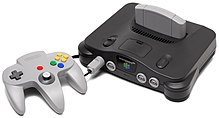
Back Nintendo 64 AN نينتندو 64 Arabic نينتندو 64 ARZ Nintendo 64 AST নিনটেনডো ৬৪ Bengali/Bangla Nintendo 64 BS Nintendo 64 Catalan نینتێندۆ ٦٤ CKB Nintendo 64 Czech Nintendo 64 Danish
 A black Nintendo 64 (right) and light gray Nintendo 64 controller | |
| Also known as |
|
|---|---|
| Developer | Nintendo IRD |
| Manufacturer | Nintendo |
| Type | Home video game console |
| Generation | Fifth |
| Release date | |
| Discontinued |
|
| Units sold |
|
| Media |
|
| CPU | NEC VR4300 @ 93.75 MHz |
| Memory | 4 MB Rambus RDRAM (8 MB with Expansion Pak) |
| Removable storage | 32 KB Controller Pak |
| Graphics | SGI RCP @ 62.5 MHz |
| Sound | 16-bit, 48 or 44.1 kHz stereo |
| Controller input | Nintendo 64 controller, 4 ports |
| Power | Switching power supply, 12 V and 3.3 V DC |
| Online services |
|
| Dimensions | 2.87 × 10.23 × 7.48 in (72.9 × 259.8 × 190.0 mm) |
| Mass | 2.42 lb (1.10 kg) |
| Best-selling game | Super Mario 64 (11.62 million)[8] |
| Predecessor | Super NES |
| Successor | GameCube |
| Related | Nintendo 64DD |
The Nintendo 64[a] (N64) is a home video game console developed and marketed by Nintendo. It was released in Japan on June 23, 1996, in North America on September 29, 1996, and in Europe and Australia on March 1, 1997. The successor to the Super Nintendo Entertainment System, it was the last major home console to use a ROM cartridge as its primary storage format. As a fifth-generation console, the Nintendo 64 primarily competed with Sony's PlayStation and the Sega Saturn.
Development began in 1993 in partnership with Silicon Graphics, using the codename Project Reality, then a test model and arcade platform called Ultra 64. The final design was named after its 64-bit CPU, which aided in the console's 3D capabilities.[citation needed] Its design was mostly complete by mid-1995 and launch was delayed until 1996 for the completion of the launch games Super Mario 64, Pilotwings 64, and the Japanese-exclusive Saikyō Habu Shōgi. The charcoal-gray console was followed by a series of color variants. Some games require the Expansion Pak accessory to increase system RAM from 4 MB to 8 MB, for improved graphics and functionality. The console mainly supports saved game storage either onboard cartridges or on the Controller Pak accessory. The 64DD peripheral drive hosts both exclusive games and expansion content for cartridges, with many further accessories plus the defunct Internet service Randnet, but it was a commercial failure and was released only in Japan.
Time named it Machine of the Year in 1996,[9] and in 2011, IGN named it the ninth-greatest video game console of all time.[10] The Nintendo 64 was discontinued in 2002 following the 2001 launch of its successor, the GameCube, having sold over 32 million units globally. The Nintendo 64 was critically acclaimed and, although it sold less than PlayStation, remained at a strong position in the United States, but it commercially failed in Japan.[11][12]
- ^ "Nintendo 64 Breaks Loose". IGN. September 26, 1996. Archived from the original on October 18, 2015. Retrieved November 12, 2015.
- ^ Kohler, Chris. "Nintendo 64 Came Out 20 Years Ago—Here's How I Felt About It then". Wired.
- ^ "Long-awaited Nintendo 64 machine hits stores". The Signal. Santa Clarita. June 24, 1996.
- ^ Younge, Gary (March 1, 1997). "Battle of the giants launched". The Guardian. London.
- ^ Curtis, Maree (March 2, 1997). "Remember the games of the old school yard". The Age. Melbourne.
- ^ "Consolidated Sales Transition by Region" (PDF). First console by Nintendo. January 27, 2021. Archived from the original (PDF) on February 24, 2011. Retrieved February 14, 2010.
- ^ Cite error: The named reference
saleswas invoked but never defined (see the help page). - ^ "All Time Top 20 Best Selling Games". May 21, 2003. Archived from the original on February 21, 2006. Retrieved March 27, 2008.
- ^ Cite error: The named reference
Fisherwas invoked but never defined (see the help page). - ^ Hatfield, Daemon. "Nintendo 64 is Number 9". IGN. Archived from the original on November 18, 2015. Retrieved November 11, 2015.
- ^ Cite error: The named reference
:0was invoked but never defined (see the help page). - ^ Loeb, Aaron John (August 1999). "News Bytes". Next Generation. No. 56. p. 12.
Cite error: There are <ref group=lower-alpha> tags or {{efn}} templates on this page, but the references will not show without a {{reflist|group=lower-alpha}} template or {{notelist}} template (see the help page).